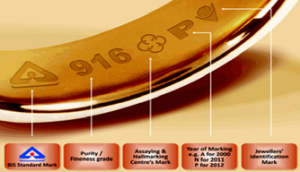
Mumbai: Purity of gold while buying a jewellery piece in India has always remained a subject of concern for consumers here. Although Indian Cabinet of Ministers has already given a nod to make Hallmarking of jewellery mandatory in January, 2012 but nothing has been done to amend the Bureau of Indian Standards (BIS) Act, 1986, that aims to expand the ambit of mandatory hallmarking to include more products, including gold.
The BIS hallmark, a mark of conformity widely accepted by the consumer, confers additional confidence upon the consumer about the quality of products like gold jewellery. But the recent report of World Gold Council (WGC) says, “Even though, 30% of jewellery is now hallmarked in India, a lot of concerns prevail about the quality and credibility of some hallmarking centres. Even hallmarked items vary widely in purity because of weak quality control and lack of resources on the part of BIS to enforce its policies.”
Mr. B Muthuvenkatram, President of Coimbatore Jewellery Manufacturers Association had once made a similar statement before a court saying, “Even jewellery having purity content of 78% or 85% are hallmarked as 916 and sometimes even a 1gram jewellery is hallmarked as 916. There is no guarantee that all the jewellery sent for hallmarking carries same purity.”
So The Indian Association of Hallmarking Centres, which represents 350 hallmarking centres across India, has recently urged the government to immediately pass the proposed amendment to BIS Act 1986 to follow proper hallmarking standard across the country. The Reserve Bank of India (RBI) has recognized the significance of hallmarking and has allowed gold loan companies to avail loan of the full value of hallmarked jewellery to borrowers.
The WGC report categorically stresses that the improvements to the hallmarking system in India are not only necessary to a successful Gold Monetization Scheme but also help to boost India’s gold jewellery exports from the existing USD8 billion to USD40 billion in the next five years.
Mr. Somasundaram P R, the MD of WGC India says, “Hallmarking is not mandatory (pending the BIS Amendment Act) and consumer awareness is limited here so Indian jewellers are neither obliged nor incentivized to become certified. Moreover, hallmarked and non-hallmarked items are sold in same outlet.”
He further stresses that many hallmarking centres here suffer from lower profitability, lack of equipments and slack processes. “Hallmarking centres should operate at a minimum 50% of capacity just to break even at the BIS stipulated price of Rs 25 per piece. Many cannot achieve this target and so they resort to price cutting and malpractice. Moreover, the BIS is not adequately staffed to fulfil its role perfectly.”
The WGC report reveals that the BIS does not have well equipped laboratories for gold hallmarking. So they have constraint capacity for testing jewellery. There are relatively few BIS branches too, so activity varies widely across India.
Meanwhile, the Indian Association of Hallmarking Centres (IAHC) is working with BIS to develop a Unique Identification Scheme for every piece of gold jewellery sold. It will have a unique 10-digit identification number and give the entire history of the piece. The scheme for hallmarked gold jewellery is to be first launched in metros followed by State capitals and then at district-level, according to information available here.
A lot still needs to be done before the idea of mandatory hallmarking can be implemented. Many consumers are not even aware of BIS hallmarking, especially those who live in rural areas. Even among educated consumers, only half are interested in or use BIS hallmarks. So increased awareness along with proper and dedicated infrastructure will drive penetration and encourage best practice.
Posted by Suresh Chotai



